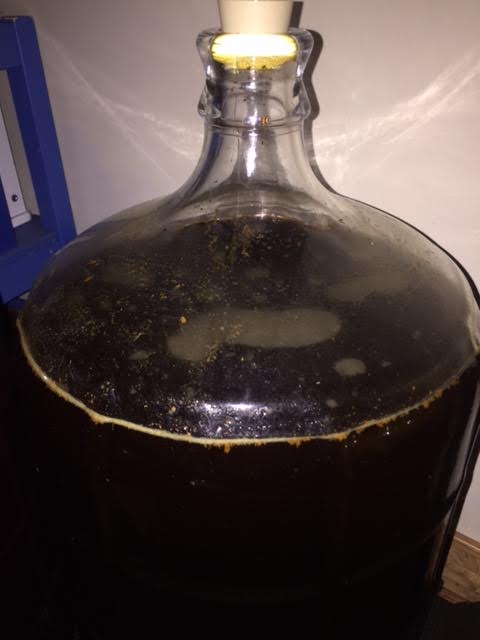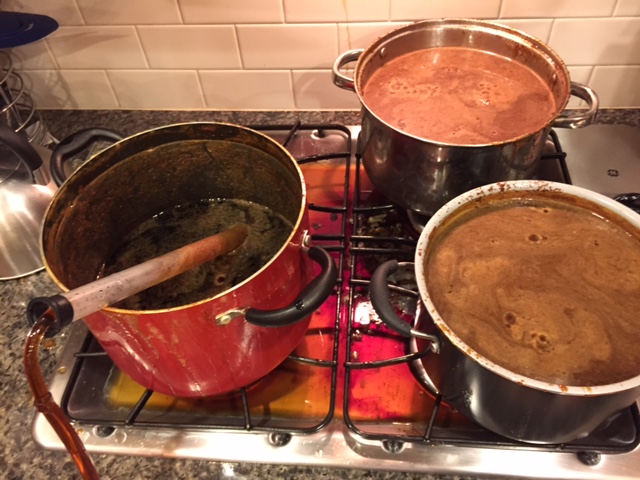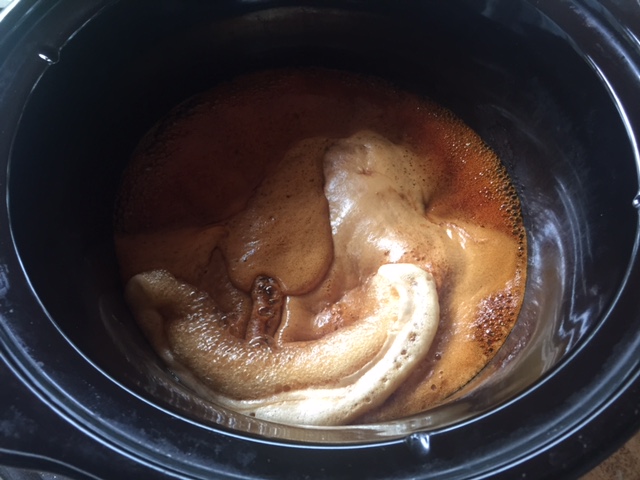Greetings everyone, my first post here. Had some fun brewing a pretty standard 5 gallon mead with a friend a few years ago but hadn't yet tried my hand at it. For some reason the idea of a burnt mead inspired me to pony up for my own brew supplies. I also went for the 6 gallon carboys (I mean why not, right?). So maybe I should have learned what I was doing on 1 gallons, but a bit late for that.
Anyways I tried this one out and the process can be described, essentially, as utter hilarity. It was a rainy day and I have no sort of large vessel for outdoor honey barbecuing so I decided to do this on the stove top. After the first massive spillover filled the whole area with about a pound of honey, I separated everything into my three biggest soup pots. Then instead of having to maniacally stir one pot for 3 hours, I was stirring 3 pots for 3 hours. Needless to say my kids thought it was funny and my wife thought I was an idiot (but as she is a true lady she just implied this with facial expressions).
Anyways I aborted at about 2.5 hours when it was very dark but not super burnt. I understand that may make an imperfect product as I read all the reviews and damn-near-nuclear (but not totally nuclear) seems to be goal; unfortunately I had to cook dinner and clean up, so for those considering this I would plan on 5 hours to be safe. The color is great, though.. had a palette on a white plate and not sure why I didn't take a picture of it.
Now as I said I made mead with a friend before. But I basically was there to drink and pour stuff and he gave me some basic tips. What I never noticed is that the airlock requires water. I mean, it's called an airlock, not a water-lock, right? Ironic because in medicine I use something for a chest tube that uses a water seal that's basically the brewing equivalent of an airlock. Anyways, after a few nights of no action whatsoever (except an amazing foam) I realized my mistake and added some water and it went pop pop pop. Hopefully I didn't damn the project but from what I can tell it probably just helped the yeast colony explode and take over the universe.
The shot of the carboy is one month in. Still popping away, now about 6 seconds. From what I can glean from the forums, I'll wait until that quits to about once a minute and then shoot it to the secondary for a few months? Been trying to find some sort of rational or scientific explanation for when to rack and bottle but I can't seem to find one... Any guidance would be great and I'll let y'all know how it turns out.


Anyways I tried this one out and the process can be described, essentially, as utter hilarity. It was a rainy day and I have no sort of large vessel for outdoor honey barbecuing so I decided to do this on the stove top. After the first massive spillover filled the whole area with about a pound of honey, I separated everything into my three biggest soup pots. Then instead of having to maniacally stir one pot for 3 hours, I was stirring 3 pots for 3 hours. Needless to say my kids thought it was funny and my wife thought I was an idiot (but as she is a true lady she just implied this with facial expressions).
Anyways I aborted at about 2.5 hours when it was very dark but not super burnt. I understand that may make an imperfect product as I read all the reviews and damn-near-nuclear (but not totally nuclear) seems to be goal; unfortunately I had to cook dinner and clean up, so for those considering this I would plan on 5 hours to be safe. The color is great, though.. had a palette on a white plate and not sure why I didn't take a picture of it.
Now as I said I made mead with a friend before. But I basically was there to drink and pour stuff and he gave me some basic tips. What I never noticed is that the airlock requires water. I mean, it's called an airlock, not a water-lock, right? Ironic because in medicine I use something for a chest tube that uses a water seal that's basically the brewing equivalent of an airlock. Anyways, after a few nights of no action whatsoever (except an amazing foam) I realized my mistake and added some water and it went pop pop pop. Hopefully I didn't damn the project but from what I can tell it probably just helped the yeast colony explode and take over the universe.
The shot of the carboy is one month in. Still popping away, now about 6 seconds. From what I can glean from the forums, I'll wait until that quits to about once a minute and then shoot it to the secondary for a few months? Been trying to find some sort of rational or scientific explanation for when to rack and bottle but I can't seem to find one... Any guidance would be great and I'll let y'all know how it turns out.


























![Craft A Brew - Safale BE-256 Yeast - Fermentis - Belgian Ale Dry Yeast - For Belgian & Strong Ales - Ingredients for Home Brewing - Beer Making Supplies - [3 Pack]](https://m.media-amazon.com/images/I/51bcKEwQmWL._SL500_.jpg)

















